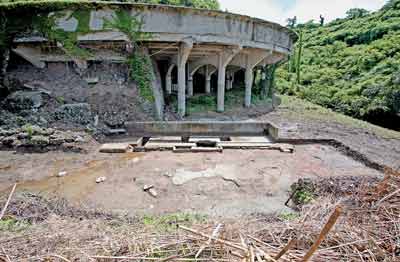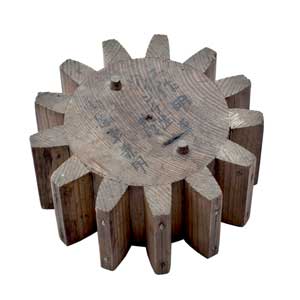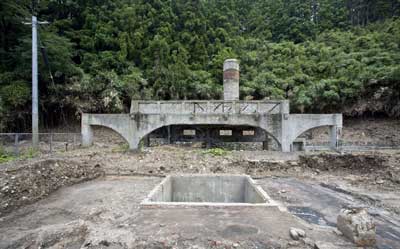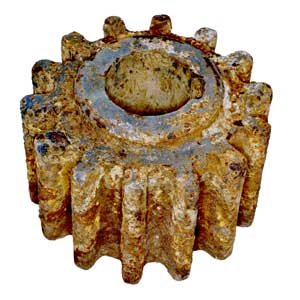Sado Kinginzan:
A government run mining facility operating from the Meiji to Heisei periods comes to light.

Panorama of the Sado Kinginzan Historic Site (from the east) The area in the center of the photo is the former Sado Mine machine tool factory complex. Through excavation the various workshops, related facilities, and work areas have been found. The portion on the left covered with greenery consists of the former Kitazawa Cyanidation/Flotation Plant and the Kitazawa Flotation Plant, facilities for the extraction and refinement of ore. |

The Kitazawa district around 1939 (from the east) The group of buildings on the right side of the photo is the machine tool factory complex. The building to the left with the very large roof is the Kitazawa Flotation Plant, called gthe largest facility in the Orient.h The prosperous condition of the Sado mine at the time can be glimpsed. |

| |
 Remains of a sawmill and multipurpose work area
Remains of a sawmill and multipurpose work area Concrete walls, floor, and machinery mounts from the second decade of the Shōwa period (1936-45) remain. Under the concrete floor, in addition to brick paving from the Meiji period, mining mortars and stone pestles thought to be from the end of the Edo period or earlier were also recovered. The photo was taken directly facing the 50-meter ore enrichment tank. | |

Plan of the machine tool factory facilities (courtesy Golden Sado Company Limited) Drawn on January 20, 1942. In the excavation, comparison was made of the layout of the buildings. The concrete walls of structures that were discovered were seen to comprise a woodworking shop, foundry, and other features of the machine tool factory complex. | |

Wooden model for casting Diameter: 11.4 cm; thickness: 5.7 cm. On the upper surface is written ggear for construction winch, [illegible] level, doubles as small gear.h Thought to have been produced in the wooden model shop between the Meiji and prewar Shōwa periods, it is one of around 70 such wooden models that survived. |

Foundry remains These are the remains of a workshop where sand molds were made from the items produced in the wooden model shop, and cast metal products (machine parts) were manufactured. Concrete pillars from the second decade of the Shōwa period, a brick-paved floor, and large amounts of sand for use in making the molds were recovered. The box-shaped feature in the center of the photo is a pit thought to have been a cistern for water as fire protection, and at the back are furnaces to melt the metal for casting. The furnacefs chimney is made with heat-resistant brick, shaped into trapezoidal or arched forms. |

Iron gear This was recovered from a facility related to the 50-meter ore enrichment tank. At 13.2 cm diameter and 9.1 cm thickness, it is relatively small but very heavy, weighing 5.2 kg. The kind of machine in which it was used is unclear. | |
Sado Kinginzan Site, Sado City, Niigata Prefecture
Introducing the latest Western technology just after the Meiji Restoration
On Sado Island, known from ancient times as a source of gold, in addition to facilities continuing to operate from the Medieval period, such as the Nishimikawa gold dust mine and the Tsurushi and Niibo silver mines, the Aikawa gold and silver mine was developed in earnest when the island came under direct control of the Edo shogunate at the start of the seventeenth century, and for the lengthy period of over 260 years it continued to support the shogunatefs finances. Under government management as the Sado Mine from the second year of the Meiji period (1869), with the latest Western technology introduced as a matter of state policy, its level of production and technology exerted great influence both domestically and internationally. Operation continued until 1989, the first year of the current Heisei period.
Various features from the Medieval to the modern age are included at the Sado Kinginzan site, and among them is the former Sado Kinginzan machine tool factory complex, located in the Kitazawa district of the Aikawa gold and silver mine, operated from the start of the Meiji period until 1952 to supply machine parts used in the equipment for quarrying, extracting, and refining. The types of machine parts made here continually supported the mining operations as essential items for every process involved.
A factory of the prewar Shōwa period comes to light
Surviving in the vicinity of the factory complex are facilities such as the Kitazawa thermal power electric generating plant, the building of the former Sado branch office for management of the crown forests, the former Kitazawa Cyanidation/Flotation Plant, the Kitazawa Flotation Plant, and a 50-meter ore enrichment tank, all retaining their forms from the Meiji to the prewar Shōwa periods.
In 2008-09, excavation was conducted in conjunction with the construction of a historic site park, and when the soil used as fill after the factories were closed was removed, building foundations such as concrete walls and pillars appeared. Comparing these features with a plan made in 1942, showing the layout of the machine tool factory facilities, the various workshops such as the woodworking shop and metal casting foundry were seen to survive just as in the plan. Beneath the concrete floor, brick paving from a Meiji period factory was found. As artifacts, metal implements thought to be machinery parts, slag from smelting, bricks and other items were recovered. From the excavation, it became possible to clarify the changes in buildings and the use of the area within the factory grounds from the start of the Meiji period, which were not well understood from documents, old photographs and plans alone. (Katori Wataru)
Adapted from Hakkutsu sareta Nihon rettō 2011 [Excavations in the Japanese Archipelago, 2011] (Bunkachō [Agency for Cultural Affairs], ed., Asahi Shimbun Publications, 2011).
